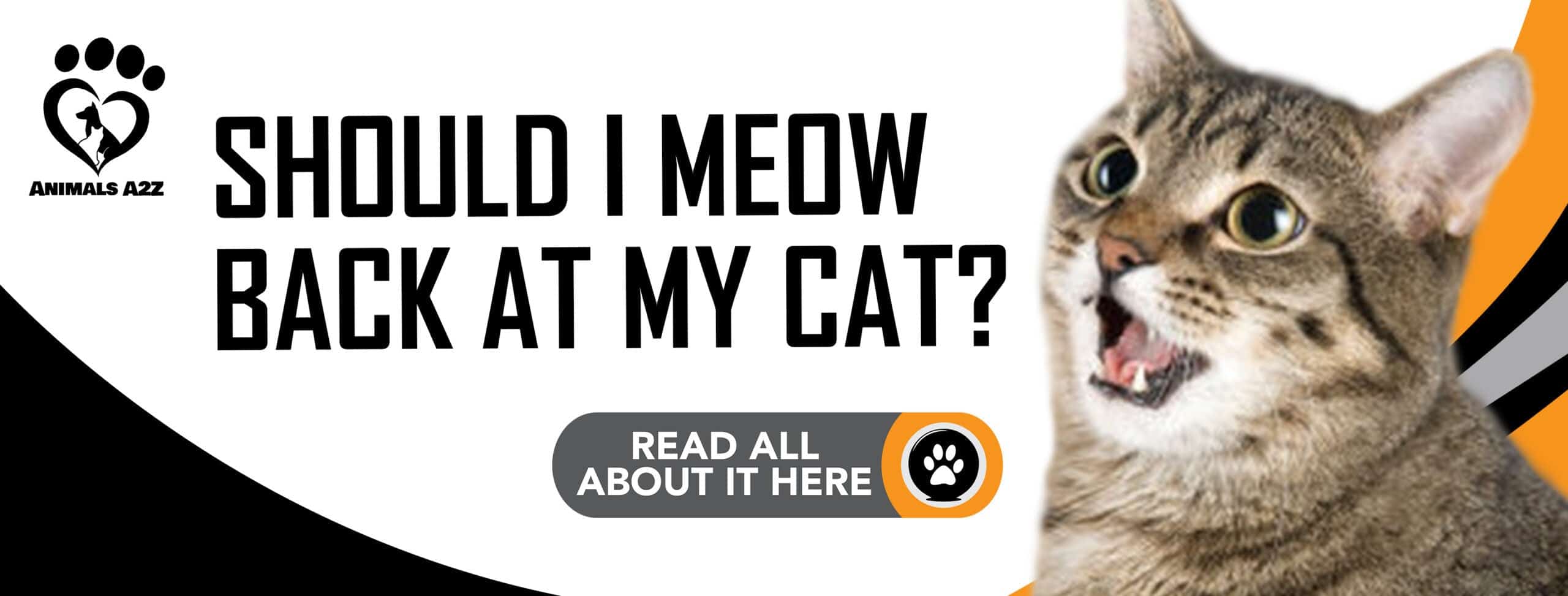Unless you are mute, have laryngitis or vocal cord paralysis, or just plain heartless, you should definitely meow back at your cat. The cat’s meow is a human-directed communication. Cats don’t meow at other cats. But instead, they communicate through scent, body language, facial expression, and touch. So even if you have no idea what you are saying back to your cat, it is only polite to address them. That’s how conversations work!
Table of Contents
Understanding the Feline Language
Cats have a myriad of ways to communicate their desires to humans, whether through purring, meowing, or chattering. Cats also yowl, squawk, scream, and more. Did you know that there are at least nineteen different types of meows? And each one of them has a different pitch, tone, volume, situation, and purposes in which the cat uses them. So what does a meow mean? Of course, every cat is unique, so there is no one size fits all cat-human decoder. Nevertheless, let me walk you through some of the standard types of meows frequent in the cat world and what they usually mean.
· A short, quick meow – This is the cat’s way of saying “hello” to you.
· Multiple Meows – If you have ever come home from a long day’s work or your cat hasn’t seen you for a while, you might have noticed that they meow several times than usual. This is their way of telling you how their day went and that they are very excited about seeing you.
· Mid-pitch Meow – If your cat ever does this, it means they’re asking to be fed or want you to give them attention.
· Drawn-out Meow – They usually let out a drawn-out meow when they’re demanding something. For instance, they might want to go out.
· Low Pitch Meow – When you’ve done something wrong, this is their way of complaining to you.
· High Pitch Meow – If you’ve ever accidentally stepped on a cattail, you might have noticed that they let out a high-pitched meow. When they do this, it means they’re angry or in pain.
Understanding what your cat is trying to tell you helps build a secure connection and foundation for your relationship. Studies on animal behavior suggest that indulging in the back and forth meowing session with your cat doesn’t really make your bond more energetic. Although, your cat will still appreciate your efforts. It can also be fun to have a meowing battle with your cat to see how long they can keep it up. But be careful because you have no idea what you’re telling your pet, and your meowing could literally mean anything to your cat.
Even though you and your cat speak different languages, you can still communicate with each other. Be mindful of your cat’s eye movement, the tone of voice, the position of their ears, and the motion of their tails. This will tell you a lot about how your cat is feeling at the moment.
[crp]
Common Questions Asked:
How can you tell if a cat is aroused?
You can tell that a cat is aroused if their arching their back with their hair raised. The cat’s pupils may also become narrowed or constricted to effectively focus more on details. Their lips will also curl a bit, and their mouth will open. Another telltale sign that a cat is aroused is when it crouches, you see its ears move back.
Do cats want/need attention?
It is a common myth that cats are low maintenance and don’t want or need much social attention. But in reality, like humans, cats are also social beings. Yes, they are solitary hunters, but when they’re not hunting, they also need companionship – especially their owner’s friendship. If you look at unowned felines and feral cats, you will notice how they’re living together in groups. A group of cats is called a clowder. They will cuddle together to sleep, to find warmth and companionship with each other.
How can you tell if your cat loves you?
You can tell that your cat loves you, when they try to follow you, lick you, or head-butt you. Rubbing its cheek against you is also a sign that your cat loves you. This ritual is of rubbing their cheek against you, or something you own is called allomarking. Cats have scent glands in their cheeks, and by rubbing them against everything like your furniture or leg, she is marking those items and people as hers. Another way they show their love is through head butting. This is when your cat puts her head down and uses her forehead to gently poke it against you. This is an adorable greeting that tells you that your cat is pleased to see you.
Conclusion
Cats are marvelous, elegant, fancy, sweet, dear companions, but they are often misunderstood. Cat owners should pay attention to how their pets communicate to adequately cater to their wants and needs. Understanding your cat also helps to create a stronger bond between them.


